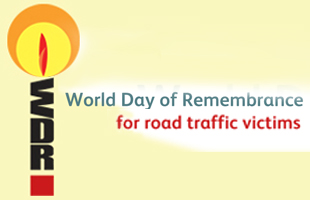
On the World Day of Remembrance for Road Traffic Victims (18 November), the World Health Organization (WHO) and the United Nations Road Safety Collaboration (UNRSC) encourage governments and civil societies to work together for road traffic safety.
"As the number of motorcycles and cars increases, the risk to motorcycle and car riders and passengers, pedestrians and cyclists increases disproportionately," says Dr Shin Young-soo, WHO Regional Director for the Western Pacific. "Leadership at the highest level is required to ensure that all relevant sectors — health, transport, police, city planning, education — play their respective roles effectively."
"Around 90% of road traffic deaths and injuries occur in low- and middle-income countries. Most of the victims are pedestrians, cyclists and motorcyclists," says United Nations Secretary-General Ban Ki-moon. "Let us commit to minimizing road traffic deaths and injuries as part of our quest for an equitable and sustainable future."
Celebrated every November on the third Sunday, the World Day of Remembrance for Road Traffic Victims was started by the nongovernmental organization RoadPeace in 1993. In the Western Pacific Region, about 350 000 people die each year as a result of road traffic crashes.
The theme for World Day of Remembrance for Road Traffic Victims 2012 is: Now is the time to learn from the past. The message relates to the United Nations Decade of Action for Road Safety 2011-2020, which has a goal of saving 5 million lives. The Decade of Action provides a framework for governments, civil societies and the private sector to work together: to improve road management; to upgrade the safety of roads and vehicles; and to educate motorists, passengers and pedestrians on safe behaviour.
Targeting motorist behaviour is an effective means to improve road safety. This entails passing and enforcing laws relating to key risk factors—such as speeding, drunk driving and failing to use helmets, seat belts or child restraints—and raising public awareness.
In countries such as the Philippines, WHO supports laws requiring helmets to meet high standards of protection for motorcyclists. WHO assisted the Department of Transportation and Communication to develop guidelines and worked with the Department of Health to promote the law's life-saving benefits.
"WHO is proud to have done its part in helping the Government to improve road safety," says Dr Soe Nyunt-U, WHO Representative in the Philippines. "By fully implementing the new law, the Government will go a long way towards reducing the unacceptable burden of deaths and injuries on the country's roads."
In Metro Manila, 34% of fatal road crashes and 37% of non-fatal injuries from road crashes involve motorcycles. Although helmet use is 98%, 57% of motorcyclists do not fasten their helmets appropriately, and 58% still lack validation stickers certifying that helmets meet the quality standards set out in the law. According to WHO, motorcycle helmets can reduce the risk of death by nearly 40% and the risk of severe injury by more than 70%. When helmet laws are enforced properly, helmet wearing rates can rise to higher than 90%.
Economic implications
Road traffic injuries cause considerable economic loss. These losses arise from the cost of treatment as well as lost productivity. Such injuries cost countries between one and three percent of their gross national product, while the loss of the breadwinner, even temporarily, can drive families into economic ruin.
Call to action
The WHO World Report on Road Traffic Injury Prevention urges policy-makers to:
- identify a lead government agency to guide the national road traffic safety effort;
- assess the problem, policies, institutional settings and capacity relating to road traffic injury;
- prepare a national road safety strategy and plan of action;
- allocate financial and human resources to address the problem;
- implement specific actions to prevent road traffic crashes, minimize injuries and their consequences, and evaluate the impact of these actions; and
- support the development of national capacity and international cooperation.
Western Pacific countries have taken steps to revise existing or adopt new road safety legislation. In China, legislation now criminalizes drunk driving. Penalties were also raised.
Positive examples abound in the Region. Malaysia introduced a helmet law that produced a 30% drop in motorcycle deaths. Researchers in Malaysia are also working to develop helmets especially for children. New Zealand's Parliament passed a land transport amendment law raising the minimum licensing age from 15 to 16 years. The law also lowers the youth drinking and driving limit to a blood alcohol level of zero for drivers younger than 20 years old.




